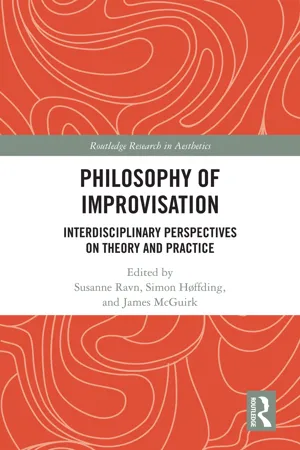
Philosophy of Improvisation
Interdisciplinary Perspectives on Theory and Practice
Susanne Ravn, Simon Høffding, James McGuirk, Susanne Ravn, Simon Høffding, James McGuirk
- 218 pages
- English
- ePUB (mobile friendly)
- Available on iOS & Android
Philosophy of Improvisation
Interdisciplinary Perspectives on Theory and Practice
Susanne Ravn, Simon Høffding, James McGuirk, Susanne Ravn, Simon Høffding, James McGuirk
About This Book
This volume brings together philosophical and interdisciplinary perspectives on improvisation. The contributions connect the theoretical dimensions of improvisation with different viewpoints on its practice in the arts and the classroom.
The chapters address the phenomenon of improvisation in two related ways. On the one hand, they attend to the lived practices of improvisation both within and without the arts in order to explain the phenomenon. They also extend the scope of improvisational practices to include the role of improvisation in habit and in planned action, at both individual and collective levels. Drawing on recent work done in the philosophy of mind, they address questions such as whether improvisation is a single unified phenomenon or whether it entails different senses that can be discerned theoretically and practically. Finally, they ask after the special kind of improvisational expertise which characterizes musicians, dancers, and other practitioners, an expertise marked by the artist's ability to participate competently in complex situations while deliberately relinquishing control.
Philosophy of Improvisation will appeal to anyone with a strong interest in improvisation, to researchers working in philosophy, aesthetics, and pedagogy as well as practitioners involved in different kinds of music, dance, and theater performances.
Frequently asked questions
Information
Table of contents
- Cover
- Half Title
- Series Page
- Title Page
- Copyright Page
- Contents
- Introduction: The Competences of Not Being in Control
- Part I Reconsidering Improvisation
- Part II Specific Aspects of Improvisational Practices
- Part III Improvisation in Practice
- Afterword: ‘Yes, and …’: Having It All in Improvisation Studies
- List of Contributors
- Index